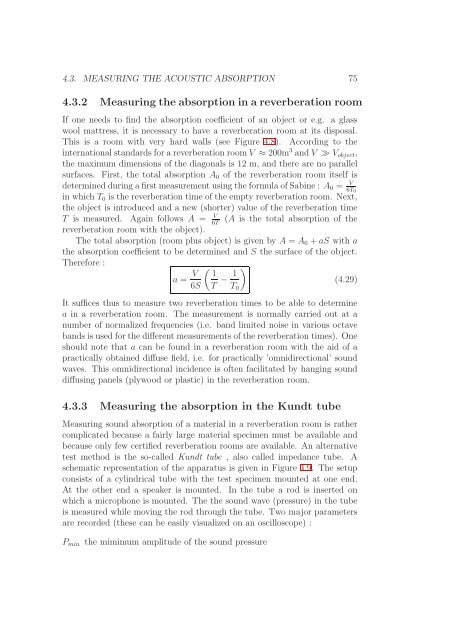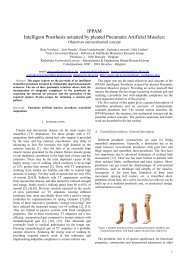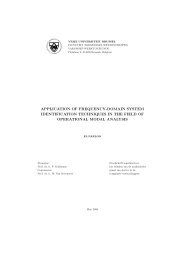VRIJE UNIVERSITEIT BRUSSEL Acoustics - the Dept. of ...
VRIJE UNIVERSITEIT BRUSSEL Acoustics - the Dept. of ...
VRIJE UNIVERSITEIT BRUSSEL Acoustics - the Dept. of ...
Create successful ePaper yourself
Turn your PDF publications into a flip-book with our unique Google optimized e-Paper software.
4.3. MEASURING THE ACOUSTIC ABSORPTION 754.3.2 Measuring<strong>the</strong> absorption in areverberation roomIf one needs to find <strong>the</strong> absorption coefficient <strong>of</strong> an object or e.g. a glasswool mattress, it is necessary to have a reverberation room at its disposal.This is a room with very hard walls (see Figure 4.8). According to <strong>the</strong>internationalstandardsforareverberationroomV ≈ 200m 3 andV ≫ V object ,<strong>the</strong> maximum dimensions <strong>of</strong> <strong>the</strong> diagonals is 12 m, and <strong>the</strong>re are no parallelsurfaces. First, <strong>the</strong> total absorption A 0 <strong>of</strong> <strong>the</strong> reverberation room itself isdeterminedduringafirstmeasurement using<strong>the</strong>formula<strong>of</strong>Sabine: A 0 = V6T 0in which T 0 is <strong>the</strong> reverberation time <strong>of</strong> <strong>the</strong> empty reverberation room. Next,<strong>the</strong> object is introduced and a new (shorter) value <strong>of</strong> <strong>the</strong> reverberation timeT is measured. Again follows A = V (A is <strong>the</strong> total absorption <strong>of</strong> <strong>the</strong>6Treverberation room with <strong>the</strong> object).The total absorption (room plus object) is given by A = A 0 +aS with a<strong>the</strong> absorption coefficient to be determined and S <strong>the</strong> surface <strong>of</strong> <strong>the</strong> object.Therefore :a = V ( 16S T − 1 )(4.29)T 0It suffices thus to measure two reverberation times to be able to determinea in a reverberation room. The measurement is normally carried out at anumber <strong>of</strong> normalized frequencies (i.e. band limited noise in various octavebandsisusedfor<strong>the</strong>different measurements <strong>of</strong><strong>the</strong>reverberation times). Oneshould note that a can be found in a reverberation room with <strong>the</strong> aid <strong>of</strong> apractically obtained diffuse field, i.e. for practically ’omnidirectional’ soundwaves. This omnidirectional incidence is <strong>of</strong>ten facilitated by hanging sounddiffusing panels (plywood or plastic) in <strong>the</strong> reverberation room.4.3.3 Measuring <strong>the</strong> absorption in <strong>the</strong> Kundt tubeMeasuring sound absorption <strong>of</strong> a material in a reverberation room is ra<strong>the</strong>rcomplicated because a fairly large material specimen must be available andbecause only few certified reverberation rooms are available. An alternativetest method is <strong>the</strong> so-called Kundt tube , also called impedance tube. Aschematic representation <strong>of</strong> <strong>the</strong> apparatus is given in Figure 4.9. The setupconsists <strong>of</strong> a cylindrical tube with <strong>the</strong> test specimen mounted at one end.At <strong>the</strong> o<strong>the</strong>r end a speaker is mounted. In <strong>the</strong> tube a rod is inserted onwhich a microphone is mounted. The <strong>the</strong> sound wave (pressure) in <strong>the</strong> tubeis measured while moving <strong>the</strong> rod through <strong>the</strong> tube. Two major parametersare recorded (<strong>the</strong>se can be easily visualized on an oscilloscope) :P min <strong>the</strong> mimimum amplitude <strong>of</strong> <strong>the</strong> sound pressure
















